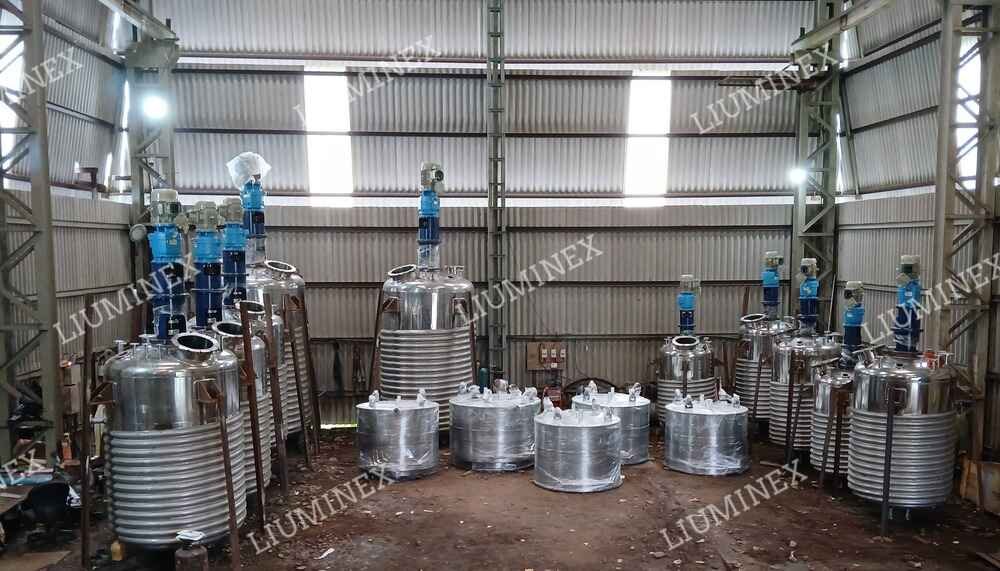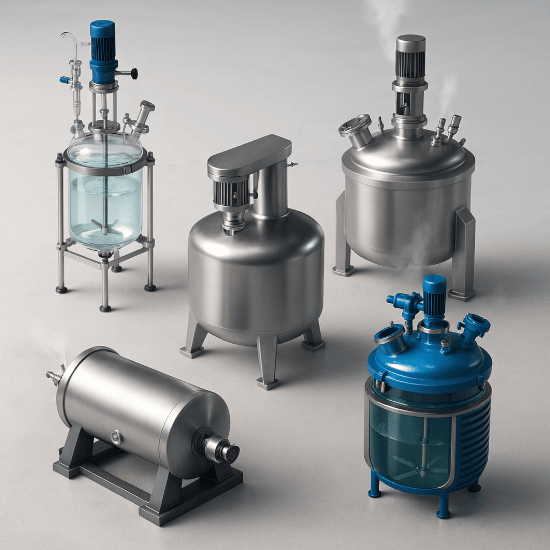"Understanding Types of Reaction Vessels and Their Industrial Applications"
In chemical and process industries, the reaction vessel is the heart of any production setup. Whether synthesizing APIs in pharmaceuticals or manufacturing resins, dyes, or polymers, the type of reactor chosen directly impacts product yield, safety, and cost-efficiency. Understanding the various types of reaction vessels, their construction, and use-cases is crucial for selecting the best fit for your application.
This in-depth guide explores the most common types of reaction vessels, their benefits, construction materials, and typical industrial applications—helping engineers, plant heads, and project consultants make informed decisions.
1. What is a Reaction Vessel?
A reaction vessel (also called a chemical reactor) is a closed container designed to contain chemical reactions. It ensures that reaction conditions like temperature, pressure, agitation, and material flow are optimized and controlled.

Key Functions:
Containment of reactants/products
Heat transfer
Mixing/agitation
Pressure management
Product discharge or continuous flow
2. Primary Classifications of Reaction Vessels
There are many ways to categorize reaction vessels based on design, mode of operation, or construction materials. The two primary classifications are:
Based on Operation:
Batch Reactors
Most common in pharmaceuticals and specialty chemicals
Reaction takes place in discrete batches
Easy to clean, inspect, and customize
Continuous Flow Reactors
Ideal for large-volume production
Reactants continuously enter, and products exit
Requires advanced control systems
Semi-Batch Reactors
Combines elements of both batch and continuous
Reactants are added in stages during the reaction

Based on Heat Transfer Design:

Jacketed Reactors
Outer jacket for heating/cooling fluid
Used for moderate temperature control
Limpet Coil Reactors
External half-pipe coil for thermic fluid/steam
Handles higher pressures and temperatures
Common in resin and petrochemical plants
3. Types of Reaction Vessels by Construction Material
Choosing the right Material of Construction (MOC) depends on the chemical properties of the reactants and process conditions.
Stainless Steel Reaction Vessels

Grades: SS304, SS316, SS316L
Features: Corrosion-resistant, high strength, GMP-compliant
Applications: API synthesis, fine chemicals, food-grade processes
SS316L is especially suitable for aggressive chemical environments and is widely used in pharmaceutical reactors.
Glass-Lined Reactors
- Steel vessel lined internally with a chemically inert glass coating
Highly resistant to acids, halogens, and corrosive solvents
Easy to clean and inspect
- Ideal For:
Acidic reactions
Fine chemicals
Dye and pigment manufacturing
Multistep reactions
- Note: Avoid using glass-lined vessels for processes with strong alkalis or sudden temperature shocks.

MS (Mild Steel) Vessels with Rubber/FRP Lining

Cost-effective for non-corrosive or moderately corrosive applications
Often used in fertilizer, polymer, and water treatment sectors
Limitations:
Lower lifespan
Not suitable for precision reactions or GMP plants
Hastelloy, Titanium & Exotic Alloy Vessels
Used for extremely corrosive processes (e.g., nitric acid, sulfuric acid at high temperature)
High initial cost, but long-term reliability
Used in:
Agrochemicals
Explosive intermediates
Chlorinated solvent-based processes

4. Types of Reaction Vessels Based on Mixing Mechanism
Proper agitation is essential to ensure heat and mass transfer within the reactor. The vessel design varies accordingly.
Anchor Type Agitated Reactor

Ideal for high-viscosity materials
Common in polymerization and resin synthesis
Includes baffles to eliminate vortex formation
Turbine Agitator Reactors
Suitable for low-viscosity fluids and rapid blending
Provides radial flow and enhanced turbulence
Often used in aqueous solutions and neutralizations

Contra-Rotating Agitator Vessels

Two impellers rotating in opposite directions
Provides uniform shear and mixing
Perfect for emulsions, dispersions, and exothermic reactions
Magnetic Stirred Reactors
No mechanical seals—ideal for sterile/GMP applications
Used in biotech and pharma fermentation systems

5. Specialized Types of Reaction Vessels
Autoclaves / High-Pressure Reactors

- Designed for high-pressure, high-temperature synthesis (hydrogenation, polymerization)
Often constructed from SS316 or Inconel
Comes with safety interlocks and rupture discs
Rotary Vacuum Reactors (RVPD)
Combines mixing, heating, and drying in a vacuum
Widely used for solvent recovery and drying APIs
Reduces drying time and improves purity

Jacketed Glass Reactors (Lab Scale)

Used for pilot and R&D operations
Visual monitoring of reaction
Comes with reflux condenser, dosing funnel, and temperature probe
6. Applications of Reaction Vessels in Industries
Each industry has its own set of requirements. Here’s how different sectors apply various types of reactors:
| Industry | Common Vessel Type | Key Considerations |
|---|---|---|
| Pharmaceuticals | SS316L Jacketed, Glass-lined | GMP compliance, sterile design, CIP system |
| Agrochemicals | Limpet coil SS316, MS vessels | Exothermic control, corrosion resistance |
| Polymers/Resins | Contra agitator, Limpet coil | High-viscosity handling, high-temp capability |
| Dyes & Pigments | Glass-lined, MS-Rubber lined | Acid resistance, color stability |
| Food & Flavors | SS316 jacketed with anchor mixer | Sanitary design, temperature control |
| Specialty Chemicals | Hastelloy, Glass-lined vessels | Multi-step reactions, pressure handling |
7. Key Design Considerations When Choosing a Reaction Vessel
To select the right type of reactor, consider the following:
-
Chemical Compatibility: Use chemical compatibility charts with MOC options.
-
Reaction Type: Exothermic vs endothermic determines jacket/coil requirement.
-
Pressure & Temperature: Specify max operating limits and build safety margins.
-
Scale & Volume: Always plan for 10–20% buffer over working volume.
-
Cleaning Requirements: CIP vs manual, GMP mandates, internal polish level.
-
Safety Features: PRV, rupture discs, interlocks, insulation, grounding.
-
Automation Needs: DCS/PLC support, instrumentation, SCADA-ready.
8. Common Mistakes to Avoid
Using SS304 where SS316L is needed (leads to corrosion).
Undersizing jackets or coils for heat transfer.
Ignoring future process scale-up needs.
Installing vessels without proper agitation analysis.
Not considering cleaning/accessibility for GMP processes.
Choosing the correct type of reaction vessel is more than a purchase—it’s an investment in the safety, efficiency, and scalability of your chemical processing plant. By understanding the differences between vessel types and their applications, engineers and plant managers can ensure optimal production performance and regulatory compliance.
At Liuminex Projects and Equipments Pvt. Ltd., we specialize in designing and manufacturing reaction vessels tailored to your unique chemical processes—from GMP-certified pharmaceutical reactors to high-performance resin vessels.

